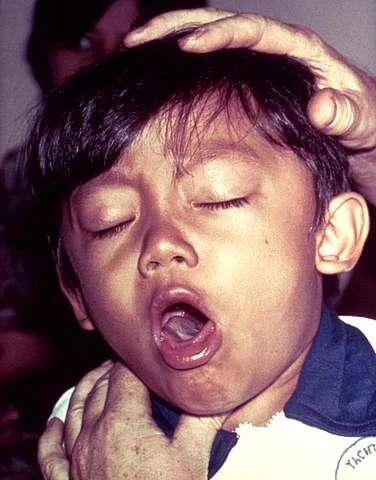- What Is Croup Cough?
- Causes and Risk Factors
- Symptoms of Croup Cough
- Diagnosing
- Treatment and Management
- Complications and When to See a Doctor
- Prevention
- Innovations in Croup Diagnosis
- Summary and Final Tips for Parents
What Is Croup Cough?
Croup cough is a medical term used to describe a specific type of cough that results from the swelling of the upper airways, particularly the larynx and trachea. This condition, commonly known simply as croup, is a respiratory illness that primarily affects children between the ages of six months and three years. The hallmark of croup cough is its distinctive barking sound, which can be alarming to parents and caregivers. It is often accompanied by a hoarse voice, stridor (a high-pitched wheezing sound during inhalation), and breathing difficulties. These symptoms tend to intensify at night, causing disrupted sleep and increased anxiety. Understanding the nature and triggers of croup cough can help parents manage the condition more effectively and know when professional medical assistance is needed.
Causes and Risk Factors of Croup Cough
The primary cause of croup is a viral infection, most commonly from parainfluenza virus types 1 and 3. Other causative viruses include respiratory syncytial virus (RSV), influenza A and B, adenovirus, metapneumovirus, and coronavirus. In rare cases, bacterial infections such as Mycoplasma pneumoniae or Corynebacterium diphtheriae may cause more severe symptoms.
Who Is at Risk for Croup Cough?
- Children between 6 months and 3 years old
- Boys are slightly more affected than girls
- Children with recent cold or upper respiratory infections
- Those with narrow airways or a history of intubation
- Children with asthma, allergies, or recurrent respiratory issues
Symptoms of Croup Cough
Croup cough typically presents with the following symptoms:
Common Symptoms
- Barking cough
- Hoarse voice
- Inspiratory stridor
- Mild fever
- Runny nose
- Worsening symptoms at night
Severe Symptoms (Seek Immediate Medical Attention)
- Difficulty breathing or rapid breathing
- Bluish tint around lips or fingernails
- Lethargy or unusual sleepiness
- Drooling or refusal to swallow
- Chest retractions, grunting, or wheezing
Diagnosing Croup Cough
Doctors typically diagnose croup through a child’s medical history and physical examination. Further tests are usually unnecessary but may be conducted to exclude conditions like epiglottitis, bacterial tracheitis, or airway obstruction by a foreign body.
Diagnostic Tools
- Westley Croup Score for severity classification
- Observation of breathing and cough characteristics
- Pulse oximetry for oxygen levels in more serious cases
Treatment and Management of Croup Cough
Most children with croup recover at home with simple care. However, moderate to severe cases may need medication or hospital care.
At-Home Care for Mild Croup
- Keep the child calm and upright
- Offer plenty of fluids
- Use acetaminophen or ibuprofen for fever or discomfort
- Avoid steam inhalation, as it’s not proven effective
- Check regularly, particularly during the night
Medical Treatment Options
- Dexamethasone (oral, intramuscular, or IV) – a corticosteroid that eases swelling and improves breathing
- Nebulized epinephrine – for rapid relief in moderate to severe cases
- Oxygen therapy – for low oxygen levels
- Hospital monitoring – for severe breathing difficulties or lack of improvement
Complications and When to See a Doctor
Potential Complications
- Respiratory failure requiring emergency intervention
- Secondary bacterial infections like tracheitis or pneumonia
- Pulmonary edema
- Rare fatalities (less than 0.5% in hospitalized cases)
When to Seek Immediate Help
- Persistent or worsening difficulty breathing
- Skin turns blue, gray, or pale
- Child is limp, hard to wake, or disoriented
- No improvement after 3–5 days
- Excessive drooling or discomfort when lying down
Prevention of Croup Cough
Vaccination Strategies
- Ensure routine influenza and diphtheria vaccinations are up-to-date
Hygiene Measures
- Encourage frequent hand washing
- Clean shared surfaces and toys regularly
- Keep sick children away from others
- Avoid sharing drinks, utensils, or towels
Innovations in Croup Diagnosis
Advances in Technology
Recent developments in automated cough sound analysis using cochleagram image features (CIF) and mel-frequency cepstral coefficients (MFCCs) are improving early diagnosis. This technology shows promise with over 88% sensitivity and 91% specificity, making it a valuable tool in telehealth environments.
Such advancements may support faster care decisions, reduce emergency visits, and improve access to diagnosis in remote areas.
Summary and Final Tips for Parents
While croup may sound alarming, it is usually mild and treatable with proper care. Recognizing symptoms early, providing comfort, and knowing when to seek medical attention are key to a safe recovery. Preventative measures like vaccinations and good hygiene practices go a long way in reducing risks. Stay calm, stay informed, and know that with appropriate care, most children bounce back quickly.
The following post may interest you
When Should I Worry About a Baby’s Cough?
Sources
Cough sound analysis for diagnosing croup in pediatric patients using biologically inspired features
https://ieeexplore.ieee.org/abstract/document/8037875
Croup in children
https://www.cmaj.ca/content/185/15/1317.short
Croup: Diagnosis and Management
https://www.aafp.org/pubs/afp/issues/2018/0501/p575.pdf
Croup
https://www.thelancet.com/pdfs/journals/lancet/PIIS0140673608601701.pdf
Croup

